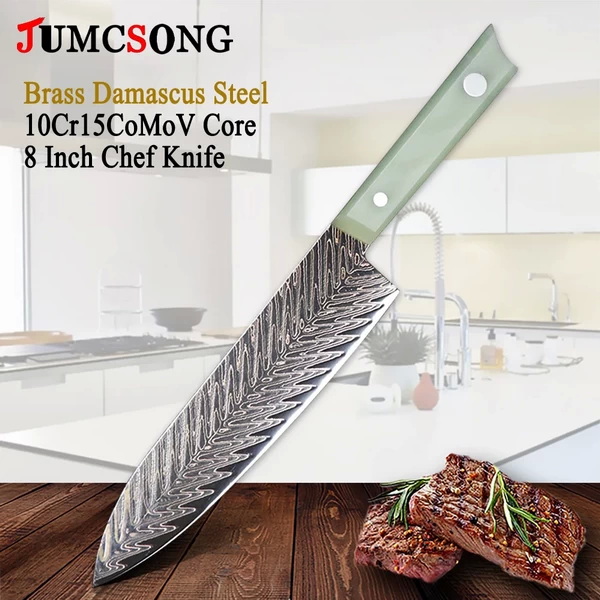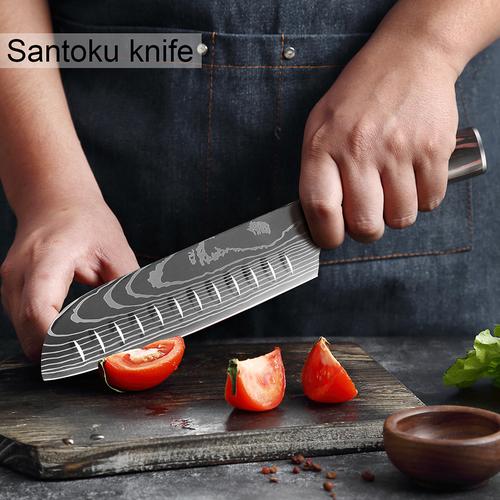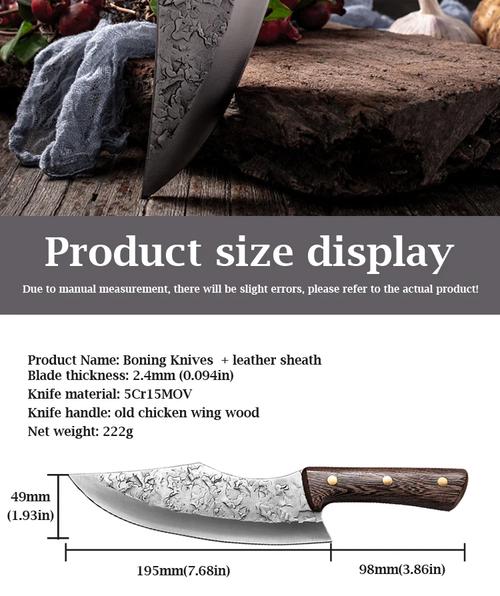

Views: 222 Author: Ella Publish Time: 2025-05-06 Origin: Site








Content Menu
● What Determines the Lifespan of a Knife Set?
● Types of Knife Sets and Their Durability
>> High-Carbon Stainless Steel Knives
● Essential Maintenance for Longevity
>> Cleaning
>> Storage
● Advanced Tips for Prolonging Knife Life
>> Handle Care
>> Avoiding Cross-Contamination
>> Proper Use
● Signs Your Knife Set Needs Replacing
● Video: Knife Set Unboxing and Care Tips
>> Video: Sharpening and Cleaning Knives
>> 1. How long should a quality knife set last?
>> 2. What is the best way to sharpen kitchen knives?
>> 3. Can I put my knives in the dishwasher?
>> 4. What type of cutting board is best for knife longevity?
>> 5. When should I replace my knife set?
A quality knife set is the cornerstone of every kitchen, blending craftsmanship, materials, and care into tools that can last a lifetime. But how long should a quality knife set really last? What factors influence their lifespan, and how can you ensure your investment stands the test of time? This comprehensive guide explores everything you need to know about the longevity of knife sets, maintenance tips, signs of replacement, and answers to the most common questions.

The lifespan of a knife set is influenced by several key factors:
- Blade Material: High-carbon stainless steel, carbon steel, ceramic, and Damascus steel each have unique durability profiles.
- Manufacturing Quality: Forged knives, especially those made in the USA, Germany, or Japan, are often more durable than stamped or mass-produced sets.
- Usage Habits: Frequent heavy use, improper cutting surfaces, or misuse (like using knives to open cans) can shorten their life.
- Maintenance and Care: Regular sharpening, proper washing, and correct storage extend a knife's functional life.
A well-made, properly maintained knife set can last decades, and in many cases, a lifetime.
Expanding on these factors, the blade material plays a crucial role in determining how long your knives will stay sharp and functional. High-carbon stainless steel is favored for its balance of hardness and corrosion resistance, making it a popular choice for both professional chefs and home cooks. Carbon steel knives, while offering superior sharpness, require more diligent care to prevent rust and discoloration. Ceramic knives, though extremely sharp and resistant to acids, are brittle and can chip easily, limiting their lifespan if not handled carefully.
Manufacturing quality is another critical aspect. Forged knives, which are crafted from a single piece of steel and shaped under high heat and pressure, tend to be stronger and more durable than stamped knives, which are cut from a sheet of steel. The countries known for producing high-quality knives, such as Japan, Germany, and the USA, have long-standing traditions and expertise in knife making, often reflected in the longevity of their products.
Usage habits can significantly impact the lifespan of your knife set. Using knives on inappropriate surfaces like glass or stone can dull the blades quickly. Additionally, using knives for tasks they are not designed for, such as prying open cans or cutting through bones, can cause damage. Proper use and respect for the tool are essential for maintaining its condition.
Maintenance and care are perhaps the most controllable factors. Regular honing aligns the blade's edge, while sharpening removes metal to restore sharpness. Proper cleaning and drying prevent rust and corrosion, and safe storage protects the blades from damage.
High-carbon stainless steel knives combine the best of both worlds: the sharpness and edge retention of carbon steel with the corrosion resistance of stainless steel. These knives are versatile and relatively easy to maintain, making them a favorite among many users. They hold their edge well but still require regular honing and occasional sharpening to perform at their best.
Carbon steel knives are prized for their sharpness and ability to take a very fine edge. However, they are more susceptible to rust and discoloration, which means they need to be dried immediately after washing and occasionally oiled to maintain their condition. Many professional chefs prefer carbon steel knives for their superior cutting performance, despite the extra care required.
Damascus steel knives are known for their striking patterns and exceptional durability. The layered construction not only adds to their aesthetic appeal but also enhances their strength and edge retention. These knives require careful maintenance to prevent corrosion, but with proper care, they can last a lifetime and become heirloom pieces.
Ceramic knives are incredibly sharp and lightweight, making them easy to handle. They are resistant to acids and oils, which means they don't rust or corrode. However, their brittleness makes them prone to chipping or breaking if dropped or used improperly. They are best suited for slicing fruits, vegetables, and boneless meats.
- Cutco: Known for lifetime durability and high-carbon stainless steel blades, Cutco offers a comprehensive warranty and excellent customer service.
- Lamson: Combining tradition and innovation, Lamson knives feature riveted handles and forged blades, offering both durability and comfort.
- Rada Cutlery: Affordable yet made from surgical-grade steel, Rada knives provide good performance for budget-conscious buyers.
Expanding on brand reputation, it's important to consider warranty and customer support when investing in a quality knife set. Brands that stand behind their products with lifetime warranties often reflect confidence in their durability and craftsmanship.
Proper care is the most critical factor in how long your knife set will last. Here's how to maximize their lifespan:
- Always hand wash with mild soap and water.
- Dry knives immediately to prevent rust and water spots.
- Never use abrasive sponges or put knives in the dishwasher.
Expanding on cleaning, it's important to avoid soaking knives for extended periods, as this can loosen handles and promote rust. Using a soft cloth or sponge helps preserve the blade's finish.
- Regularly hone your knives with a honing rod to maintain the edge.
- Sharpen with a whetstone or have them professionally sharpened as needed.
- Avoid over-sharpening, which can wear down the blade prematurely.
Sharpening techniques vary depending on the knife type. For example, Japanese knives often require a different sharpening angle than Western knives. Learning the correct technique or seeking professional sharpening services can extend the life of your knives.

- Store knives in a knife block, on a magnetic strip, or in blade guards.
- Avoid storing knives loose in drawers to prevent chipping and dulling.
Proper storage not only protects the blades but also ensures safety in the kitchen. Magnetic strips keep knives accessible and visible, while blade guards are useful for transporting knives safely.
- Use wood or bamboo cutting boards.
- Avoid glass, marble, or ceramic surfaces, which can damage blades.
Wood and bamboo cutting boards are gentle on knives and have natural antimicrobial properties. Regularly oiling wooden boards helps maintain their surface and prolongs their usability.
Conduct regular inspections of your knives for any signs of wear, such as micro-chips, bent tips, or loose handles. Early detection allows for timely repairs or adjustments before major damage occurs.
While home sharpening is effective, periodic professional sharpening ensures the blade is restored to its optimal edge geometry. Professionals can also address blade chips and re-profile damaged knives.
Wooden handles require occasional oiling to prevent drying and cracking. Composite and synthetic handles are more resistant to moisture but should still be checked for signs of wear or separation from the blade.
Always clean your knives thoroughly between tasks, especially when switching between raw meats and vegetables. This not only ensures food safety but also prevents acidic substances from damaging the blade.
Use the right knife for each task. For example, use a chef's knife for chopping, a paring knife for peeling, and a serrated knife for slicing bread. Using the correct knife reduces unnecessary stress on the blade and handle.
Even the best knives may eventually need replacement. Look for these signs:
- Persistent Dullness: If sharpening no longer restores the edge, the blade may be worn out.
- Chips, Cracks, or Bent Blades: Structural damage compromises safety and performance.
- Rust That Won't Come Off: Deep corrosion can't be fixed and may contaminate food.
- Loose or Broken Handles: Affects grip and safety.
- Significant Blade Wear: Noticeably reduced blade length or uneven edge.
Recognizing these signs early can prevent accidents and ensure your kitchen tools remain effective. It's better to replace a damaged knife than risk injury or poor performance.
- This video demonstrates unboxing, organizing, and caring for a new knife set, including cleaning and storage tips.
- Chef Frank Proto explains how to properly sharpen, clean, and store kitchen knives for maximum longevity.
A quality knife set is a long-term investment that, with proper care, can last a lifetime. The key factors influencing longevity are the materials, craftsmanship, and-most importantly-how you care for your knives. Regular hand washing, proper storage, regular honing and sharpening, and using the right cutting surfaces will keep your knives sharp, safe, and effective for years. Recognize the signs of wear and replace knives only when absolutely necessary. With these best practices, your knives will remain the most reliable tools in your kitchen.

A quality knife set can last decades or even a lifetime with proper care and maintenance.
Use a whetstone for sharpening, hone regularly, and seek professional sharpening once a year for best results.
No. Always hand wash and dry knives immediately to prevent damage.
Wood or bamboo cutting boards are best; avoid hard surfaces like glass or marble.
Replace knives if they remain dull after sharpening, have cracks, chips, rust that can't be removed, or damaged handles.